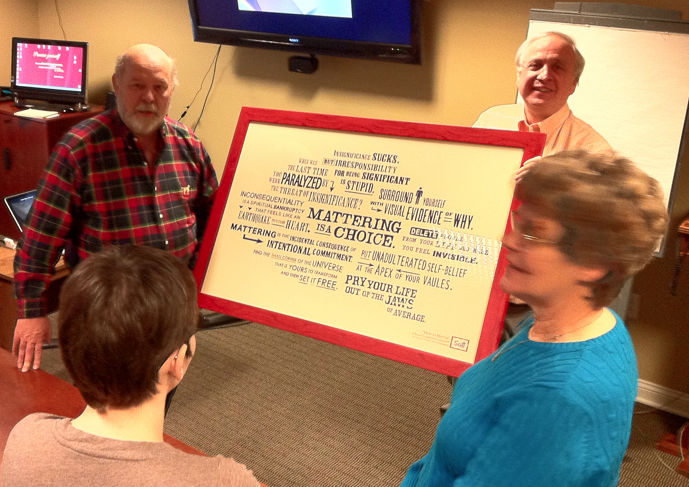 Good brands are bought — great brands are joined.
Good brands are bought — great brands are joined.
Here’s what I mean:
To join a brand is to connect with it on a visceral level. To join a brand is to engage with it on a human level. To join a brand is to unite with it on a personal level.
Otherwise people are just giving you money.
Today we’re going to explore a collection of ideas to help your brand become more joinable.1. Surrender is the new control. Here’s the mistake stupid brands make: Instead of satisfying a compelling need, they project onto the market what they think they ought to want. Like the startup that invests thousands of dollars creating an elegant solution to a problem nobody has. Or the non-profit that drains the entire budget conserving irrelevant resources that are going extinct anyway.
In short: People fall love with their own marketing without recognizing that it’s already engaged to someone else.
Sounds like a bad country song to me.
If you want to make your brand more joinable, master the art of sweet surrender. Enable people to take your idea into their own hands by openly embracing a fan mentality.
For example, Scott Adams allows any of his readers to mash up his daily Dilbert comic strip. And if they’re funnier than his version, he’ll publish them. This demonstrates trust, transfers ownership to the customer and leverages vulnerability into viability. Does your brand do that?
As I learned from Vicki Kunkel’s book, Instant Appeal, “People who exhibit some sort of visual vulnerability relax out defenses and get greater support for their causes and companies.”
Remember: It’s not your job to tell customers how to consume you. Their taste puts food in your mouth – listen to it. Are you willing to give up some control of your brand in exchange for being able to let grow and expand it better and faster?
2. Inbreak is the new outreach. Outreach is outdated. Brands that claim to “start with the customer in mind” are full of crap. What they’re really trying to do is figure out how customers fit into their nice little marketing plan so they can bother them into buying something they don’t need.
Nice try, Don Draper, but that approach is broken.
If you want customers to join your brand, here’s my suggestion: Actually start with the customer. Focus on how your brand fits into people’s lives. That’s inbreak. That’s joining people first. And when you take this counterintuitive approach, a few cool things happen.
First, you proactively meet people where they live instead of cleverly sucking them into your marketing vortex. This lowers the threat level of your offering. Second, you extend respect for people’s life situation. This demonstrates empathy, respect and boundaries.
Third, by joining people first, you make them feel seen, heard and participated in. This delivers the social gift of gratitude. And lastly, instead of proving to people that you’re the kind of brand they can live with, you allow people to show you that they’re the kind of person you can’t live without. Which of your customers are just waiting for you to join them?
3. Click is the new join. To make your brand digitally joinable, you have to make it accessible through multiple channels. The secret is to help big numbers of people join you in small moments of clicking, the aggregate of which strengthens your brand over time. Here’s a collection of options you might consider:
*Make your brand subscribeable. Syndicate your brain. How many blog posts have published?
*Make your brand followable. Recognize that you’re a writer. How many of your tweets are worth printing out?
*Make your brand friendable. Become a virtual extrovert. Whose life is better because they know you?
*Make your brand likable. Get a personal demo video. How easy are you to get along with?
*Make your brand stalkable. Establish greater photo equity. How many pictures have you posted?
*Make your brand clickable. Build remarkability into everything you publish. How many bloggers are linking to you work?
Remember: Small moments plus big numbers equals huge profits. How many digital options are you giving people to interact with your brand?
4. Show-up is the new sign-on. When I first arrived at my professional association, the president took me aside and unexpectedly told me not to join. “Just show up, hang out and ask questions. Worry about joining later. Cool?”
Well, that’s a relief, I thought.
So I took Richard’s advice. And it turned out to be a much smarter investment of my time, money and energy. Plus I didn’t have to deal with the awkward pressures of membership, dues, committees and the like. Thank god. That’s all I need: Another affiliation.
The cool part is, after two years of casually showing up, I eventually did join. Then became a board member. Then became chapter president.
Lesson learned: Sometimes the best way to become more joinable is to tell people that it’s okay not to join. What do you have to lose? Why not look them in the eye say:
“Look, we have no petitions for you to sign, no recruitment drives for you to mount, and no expectations for you to fulfill. Just relax, and enjoy hanging out with the one club that requires absolutely nothing of you. Cool?”
Who knows? They might tell everybody. Are you blinded by the illusion that everyone in the world needs what your organization offers?
5. Imperfect is the new brilliant. The customer isn’t always right – but the customer always loves being right. And if you’re so smart, why aren’t you making other people look smart? Truth is, brands that are willing to broadcast their imperfection, remain open to improvement and allow customers to make their business smarter are eminently joinable.
Netflix, for example, offered one million dollars to anyone who could improve the accuracy of their movie recommendation algorithm by ten percent. This program was called The Progress Prize. And although it earned criticism from privacy advocates – not to mention the Federal Trade Commission – you better believe it positioned their brand as more joinable.
My suggestion: Kick your addition to terminal certainty. Be smart enough to be dumb. Besides, perfectionism enables procrastination, blocks inventiveness, stains communication and slaughters playfulness. Exert your imperfect humanity and your joinability will skyrocket. Are you still laboring under the myth that you have to do everything right?
6. Engagement is the new marketing. For the past decade, I’ve never left the house without nametags. Because everywhere I go, people ask me if they can have one. And I’m happy to pass them out. To strangers, to friends, to random kids at the ballpark, whatever. My brand doesn’t discriminate.
The secret is, I don’t pass them out to make people wear nametags — I pass them out to make a point: My brand is participatory. Personally, I don’t even care if people wear the nametags. A lot of them don’t. What matters is that they join me that spontaneous moment of authentic human interaction, infused with a sprit of humor, playfulness and connection. That’s my brand. And people’s life is better because of it.
Your challenge is to determine the level of participation garnered by yours. After all, brand perception hinges on human interaction. And the only thing people can make a judgment about is how engaging with you makes them feel. I challenge you to think about how your brand could become more participative. Because encounter you have with another person either adds to – or subtracts from – its overall joinability. Do customers see your brand as a one-way street?
REMEMBER: Your people need to connect with you on a visceral level, engage with you on a human level and unite with you on a personal level.
Because it’s not enough for a brand to be bought – it has to be joined.
LET ME ASK YA THIS…
Is your brand buyable but not joinable?
LET ME SUGGEST THIS…
For the list called, “26 Ways to Out Brand the Competition,” send an email to me, and you win the list for free!
* * * *
Scott Ginsberg
That Guy with the Nametag
Author, Speaker, Entrepreneur, Mentor
[email protected]
 Who’s telling their friends about YOU?
Who’s telling their friends about YOU?
Tune in to The Marketing Channel on NametagTV.com!
Watch video lessons on spreading the word!

 “It’s not about the art – it’s about the person you become as you create the art.”
“It’s not about the art – it’s about the person you become as you create the art.”
 “It’s not about the art – it’s about the person you become as you create the art.”
“It’s not about the art – it’s about the person you become as you create the art.”